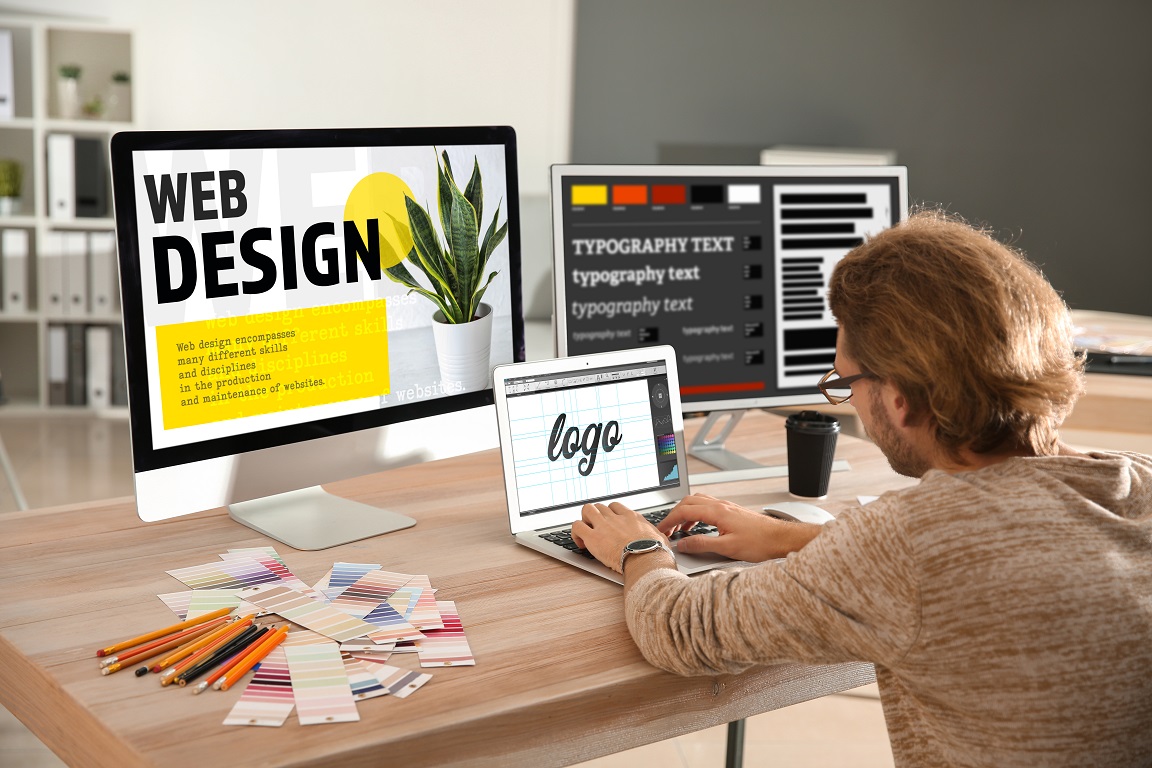Web Design London Ontario Services Customized to Your Company
Web Design London Ontario Services Customized to Your Company
Blog Article
Exactly How to Successfully Integrate Visual Appeals and Capability in Web Style
When creating a site, you need to strike an equilibrium in between appearances and functionality. It's not just regarding looking excellent; your layout ought to additionally offer an objective and guide customers effectively. By concentrating on simplicity and intuitive navigating, you can develop an engaging experience. What elements truly enhance functionality while keeping aesthetic allure? Let's check out the essential principles that can bring about a harmonious mix of beauty and feature.
Comprehending the Importance of Looks and Capability
When you develop a website, understanding the balance in between aesthetics and capability is crucial for developing an effective individual experience. An aesthetically enticing site grabs focus, however it's the capability that keeps individuals involved. Site visitors will quickly lose rate of interest and leave.Consider your target audience and what draws them in if your site looks wonderful yet is hard to browse. You intend to create a layout that shows your brand name while making sure ease of usage. Streamlined layouts, user-friendly navigation, and clear contact us to action can boost both aesthetic appeals and performance.

Principles of Effective Web Style
To create an effective web layout, you need to stick to a number of essential concepts that boost both user experience and visual charm. Focus on simplicity; a tidy format assists users browse quickly. Utilize a consistent color pattern and typography to maintain comprehensibility throughout your site. This cultivates familiarity and trust.Next, ensure your design is receptive. Individuals access internet sites on various devices, so your design needs to adapt flawlessly. Focus on visual pecking order; emphasize crucial components with shade, placement, or dimension to lead customers' focus.Finally, include enough white room. It protects against mess and makes material a lot more digestible. Bear in mind, reliable web layout equilibriums looks and capability, so every layout selection need to offer an objective. By following these concepts, you'll develop a site that's not only aesthetically enticing yet additionally straightforward, eventually maintaining visitors engaged and urging them to return.
Prioritizing Customer Experience
When prioritizing user experience, you'll wish to start by comprehending what your customers genuinely require. Simplifying navigation style can make a substantial difference in how conveniently they discover what they're searching for. Improving visual hierarchy helps guide their focus to the most vital aspects on your website.
Recognizing Customer Requirements
Comprehending user needs is necessary for creating an engaging internet experience that maintains site visitors coming back. To accomplish this, you should recognize the objectives and preferences of your target market. Start by performing user study, like surveys or interviews, to gather insights on what individuals worth most. When connecting with comparable websites, pay interest to their pain points and difficulties. This details allows you to tailor your layout, ensuring functionality lines up with individual assumptions. In addition, take into consideration developing user personalities that stand for different segments of your target market, helping you envision their requirements throughout the style procedure. When you prioritize understanding user needs, you develop a web site that not only looks terrific but also provides a smooth, pleasurable experience that fosters commitment.
Streamlining Navigating Style

Enhancing Visual Pecking Order
A strong visual power structure is essential in guiding individuals through your site and guaranteeing they engage with vital content. To accomplish this, utilize dimension, shade, and spacing tactically. Make crucial aspects like headings bigger and bolder than body text, attracting focus promptly. Make use of contrasting colors to highlight contact us to action, encouraging clicks. In addition, use ample white space to separate areas, making material absorbable and inviting.Consider the circulation of information; organize components logically, leading users' eyes from one indicate the following. Use visual cues, like lines or arrows, to route interest. By focusing on visual pecking order, you boost user experience and enhance the probability of conversions, ensuring your site is both aesthetically pleasing and functionally effective.
Color Theory and Its Effect On Usability
While choosing the appropriate shades for your internet site may feel like a minor information, it greatly affects use and user experience. Shade influences just how users regard details and can enhance or impede navigating. For example, contrasting colors can aid vital aspects stand out, making it much easier for site visitors to discover what they need.Additionally, consider the psychology of colors: blue often motivates trust fund, while red develops necessity. Knowing your target market can assist your color choices, ensuring they resonate well.Moreover, consistent color pattern aid construct brand name identification, making your website extra remarkable. Nevertheless, be cautious-- too many more info shades can overwhelm customers. Adhere to a limited palette that complements your material and maintains clarity.Incorporating availability is likewise important; confirm your color combinations get along for those with aesthetic impairments. By thoughtfully applying shade concept, you'll improve usability and develop a more engaging individual experience.
Typography: Harmonizing Style and Readability
Color choices established the phase for your website, but typography plays a just as necessary duty in improving user experience. You desire your text to interact plainly while additionally showing your brand's character. Begin by picking typefaces that are not only attractive yet additionally legible. Sans-serif font styles usually function well for digital screens, as they're less complicated to review at numerous sizes.Maintain a power structure by utilizing different typeface sizes and weights; this guides individuals via your material effortlessly. Think about line spacing and letter spacing; as well limited can frustrate viewers, while also loosened can disrupt the flow. Limit your font choices to two or three to maintain the layout cohesive.Finally, constantly evaluate your typography across different tools and web browsers. What looks great on one display might not on an additional. Balancing design with readability guarantees that your message resonates, keeping your target market informed and engaged.
Responsive Style: Making Looks Work With All Devices
To assure your internet site looks great on any kind of tool, you'll need to accept responsive style principles. This strategy assurances your website adapts to numerous display dimensions, supplying a suitable individual experience. Beginning by using liquid grids and versatile images that scale seamlessly. Instead of repaired measurements, decide for percentages and family member systems, permitting your layout to change dynamically.Next, carry out media questions in your CSS. These let you apply various styles based upon device qualities, like screen size. This means, you can preserve visual charm while ensuring functionality.Don' t ignore touch targets; make sure switches and links are simple to tap on smaller sized screens. Prioritize crucial content, so users can easily navigate your website despite their gadget. By concentrating on these elements, you'll develop an appealing, aesthetically appealing experience that satisfies the needs of all customers, whether they're on a desktop computer, smart device, or tablet computer .
Performing Use Testing for Continuous Improvement
To improve your website design, you require to set clear use objectives that align with user needs. By conducting user examinations, you can collect useful comments on just how genuine individuals connect with your site. Examining these outcomes will aid you make informed renovations and produce an extra effective user experience.
Defining Functionality Goals
While appearances can draw individuals in, defining use objectives is vital for guaranteeing their experience continues to be satisfying and seamless. Beginning by determining what you want users to attain on your site (website design london Ontario). Consider their demands, behaviors, and tasks. Are they trying to find details, making a purchase, or enrolling in a newsletter? Develop clear standards to determine success, like job conclusion prices or time on task. Prioritize intuitive navigation, obtainable material, and receptive layout to boost functionality. On a regular basis take another look at these objectives as user expectations develop. By specifying usability goals, you create a structure for reviewing and boosting your internet site's performance. This concentrate on functionality not just boosts user fulfillment however also enhances the total performance of your layout
Conducting Individual Tests
Conducting customer tests is important for improving your internet site and ensuring it satisfies your target market's requirements. Beginning by determining your target individuals and creating a test strategy that describes your goals. Make use of a mix of measurable and qualitative methods, such as studies, interviews, and task-based monitorings, to collect complete comments. Invite participants to navigate your site while you observe their communications and keep in mind any kind of difficulties they encounter. Motivate open discussion to capture their ideas and sensations about the style and functionality. Maintain sessions brief and focused, ensuring you cover vital locations without overwhelming users. Lastly, ensure to document all findings, as this information will certainly be vital for making enlightened layout choices that boost both aesthetic appeals and functionality.
Assessing Examination Results
Just how can you successfully analyze the results of your functionality tests to drive constant enhancement? Begin by classifying responses into typical themes. Seek patterns in individual habits that highlight discomfort points or areas for improvement. Use quantitative data, like job conclusion rates and time on job, to measure usability objectively. Do not neglect to take into consideration qualitative understandings from user comments; they commonly expose underlying issues that numbers can not reveal. Focus on one of the most impactful searchings for and create workable items for your design group. Keep in mind, it's concerning repeating-- implement modifications, after that test once again. This cycle of screening, analyzing, and refining helps you equilibrium appearances and functionality, guaranteeing your site satisfies user requirements efficiently while keeping visual charm.
Often Asked Concerns
How Do I Choose the Right Shade Scheme for My Website?
To pick the best shade combination for your website, consider your brand's personality, target audience, and psychological effect (website design london Ontario). Use shade psychology, develop harmony, and assurance readability. Test combinations to see what reverberates ideal with site visitors
What Devices Can Assist With Website Design Looks and Capability?
You can utilize tools like Adobe XD, Figma, and Map out to improve your web design's aesthetics and capability. These systems offer instinctive interfaces, collaboration features, and pre-made templates to streamline your imaginative process and boost your designs.
How Can I Include Animations Without Jeopardizing Functionality?
To integrate animations without jeopardizing performance, focus on subtle impacts that enhance user experience. Use CSS animations for smoother communications, warranty fast load times, and examination on different tools to keep performance while adding visual allure.
What Are Typical Errors to Prevent in Internet Design Looks?
When making, stay clear of messy formats, inadequate shade options, and inconsistent fonts. Don't ignore mobile responsiveness, as it can estrange users. Validate your design lines up with your brand name, producing a seamless experience that involves visitors successfully.
Exactly how Frequently Should I Update My Internet site's Design for Ideal Aesthetics?
You need to update your website's layout every 1-2 years to stay on par with patterns and preserve ideal visual appeals. Regularly restoring visuals assists engage guarantees and visitors your website stays attractive and straightforward. When you design a site, comprehending the balance in between looks and capability is crucial for creating a reliable customer experience. To develop an effective web layout, you need to stick to a number of key concepts that improve both customer experience and visual allure. Customers access internet sites on numerous gadgets, so your style should adjust seamlessly. When focusing on user experience, you'll want to start by recognizing what your users really require. Beginning by conducting user research, like interviews or studies, to gather insights on what individuals value most.
Report this page